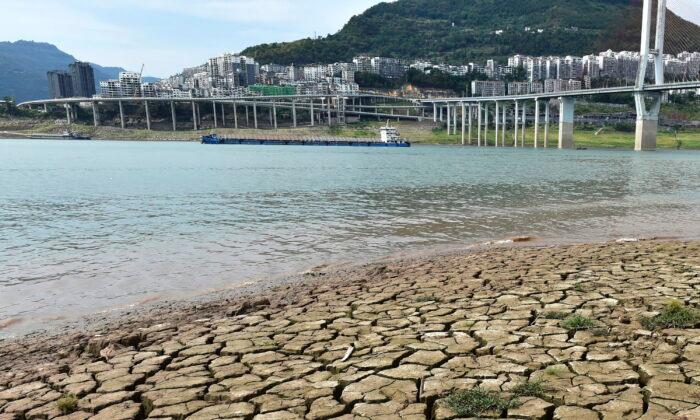China is in the middle of an intense heat wave that is breaking temperature records and drying up rivers. From Aug. 12 to 15 the Central Meteorological Observatory in China issued high-temperature warnings, and the temperature in 11 provinces exceeded 40 C (104 F). Many areas in the country broke records for the highest temperature and the number of high-temperature days. On Aug. 13, the temperature in Zhushan in Hubei Province, reached 44.6 (112 F).
The high temperatures and lack of rain are affecting waterways. The water level in the Wuhan section of the Yangtze River is at a record low; Dongting Lake and Poyang Lake dry season started earlier that usual; and in Anhui, Guizhou, Chongqing, and other provinces and cities, rivers have dried up.
Record-Breaking Temperatures
On Aug. 13, data collected by China’s 2,418 national meteorological observation stations from 11:00 a.m. to 4:00 p.m. showed that the top ten places on the temperature list exceeded 42.5 C (108.5 F). In the top ten observation stations, Chongqing had four provinces on the list, including Hubei, Shaanxi, and Sichuan. Among them, Zhushan County in Hubei Province, at 43.9 C (111 F) was the hottest.Then, at 4:37 p.m. on Aug. 13, Zhushan County, reached 44.6 C (112.3 F), breaking the high temperature record again.
Rivers Drying up
On Aug. 14, in Anqing City, Anhui Province, local media reported that the continuously high temperatures and low rainfall caused many main rivers in Huaining County to dry up and stop flowing, making it difficult to supply water for agricultural irrigation and domestic use in eight towns along the rivers. The Guache River in Tongcheng City dried up affecting the rice fields along its banks. Data from the Anqing Water Resources Bureau showed that the water level at the Anqing Station of the Yangtze River was 27.6 feet on Aug. 11—17.6 feet lower than the same period last year.Qing Yang County, Anhui Province, Flood Control and Drought Relief Command on Aug. 10 said that since July 27, Qing Yang County, according to the County meteorological department monitoring, the county’s cumulative precipitation was 0.07 inches, 97 percent less than the same period last year (2.1 inches), a level that is considered moderate drought. The drought-stricken areas of rice fields include 11,531.6 acres. The Qixing River in Heilongjiang Province and Shishan River in Guandong Province have partially dried up and are flowing slowly.
A few townships have activated backup water sources to bring water to people with a shortage of drinking water.
According to the digital newspaper The Paper, on Aug. 12, seven rivers in Chongqing had dried up and stopped flowing, one reservoir had dried up, 476 electromechanical wells had insufficient water, and 276,000 people and 82,400 head of livestock are facing a lack of drinking water due to the drought.
In Guizhou, the river upstream of the Great Falls scenic area in Zunyi’s Chishui Danxia tourist area, dried up, and ceased operations on Aug. 13.
The dry season for Dongting Lake in Hunan Province and Poyang Lake in Jiangxi Province has started early and the water level in the Wuhan section of the Yangtze River is the lowest in history for the same period.
Poyang Lake is the largest freshwater lake in China. Dongting Lake is the second largest, stretching between Hunan and Hubei provinces.
The water level of Dongting Lake dropped for over 40 days in a row and fell below the dry water level of 26.8 yards, and entered the dry season 4 months early due to the decrease in water from the upper stream of the Yangtze River coupled iwth the persistent high temperatures and low rainfall. On Aug. 13, the water level of Dongting Lake Chengling Rock Station was 26.2 yards, the lowest level for the same period in the past 30 years. Some of the tributaries and trunk canals in the northern part of Dongting Lake have dried up and stopped flowing.
On Aug. 6, Jiangxi Provincial Hydrological Monitoring Center released the news that Poyang Lake started the dry season early, the water level of Xingzi Station, the representative station of Poyang Lake, receded to 13.1 yards, the lowest level in the same period since records were kept in 1951. This was also the earliest the dry season started since 1951. Multiple large areas of the lakebed are exposed in Poyang Lake, and many lakebeds have become “grasslands.”
According to the Wuhan Flood Control and Drought Relief Command Office, as of 6 p.m. on Aug. 13, the water level at Hankou Station of the Yangtze River was 19.2 yards, and the current water level in the Wuhan section of the Yangtze River is the lowest in history for the same period since the hydrological records have been kept. The office said that in 2022, the water level of the Yangtze River continued to recede after entering the main flood season, resulting in depletion during the flood season, an extremely rare phenomenon.





Friends Read Free